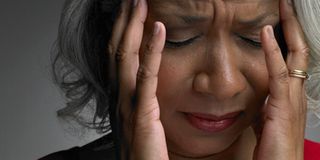Prime
How to find relief from the painful effects of menopause

Women going through menopause may experience non-specific aches, pains and irritability
What you need to know:
Menopause defines the end of a woman’s reproductive cycle. Dr Tino Salome Ongu explains the causes, symptoms and treatment for menopausal discomfort.
Menopause is defined as the permanent cessation of ovulation and menstruation lasting for more than nine to 12 months in women aged between 45 to 55 years.
As the woman reaches the age of 45-55 years, there is a natural exhaustion of the oocyte (egg) store in the ovaries which leads to reduced production of the female hormone oestrogen. Insufficient oestrogen production fails to stimulate the endometrium (womb lining) and menstrual periods stop.
The diagnosis of menopause is made clinically by taking a thorough history of symptoms and cessation of menstruation for a period of 12 months. If required, such as in cases of premature menopause, the diagnosis can be confirmed by elevation of gonadotrophins (FSH) and low oestrogen.
Perimenopause is the time before menopause when the menstrual cycle begins to get irregular and takes approximately three to four years.
During this time, most women in their forties notice irregular scanty periods, some will have a sudden stop of menses or still others will have heavy menses and eventually, menopause sets in.
Post menopause is the time after menopause and the rest of the woman’s life until old age. The ovaries in postmenopausal women are small and wrinkled.
Premature ovarian insufficiency, also known as early or premature menopause is the loss of ovarian function before the age of 40 to 45. It affects approximately one per cent of women before the age of 40 and five per cent before the age of 45. These women may present with no periods, irregular periods, sub-fertility or menopausal symptoms. Any woman under 45 years of age with any symptoms of menstrual irregularities lasting longer than three months and not on hormonal contraception should be investigated to find out the cause.
Causes of premature menopause
Early menopause may be due to:
Radiotherapy: the treatment of cancer using ionising radiation to kill cancer cells and shrink tumours.
Chemotherapy: the treatment of cancer with drugs that destroy cancer cells.
Surgical removal of the ovaries
Chromosome abnormalities where there is an abnormal number of chromosomes either as extra pieces or missing fragments.
Autoimmune disease: where the body’s immune system turns against itself and mistakenly attacks healthy cells.
Infections such as HIV/Aids, mumps and tuberculosis.
Genetic disorders such as Turner syndrome and the Fragile X permutation.
Signs of menopause
1.Osteoporosis is a condition of the skeleton in which bone strength is compromised, leading to weakness in the skeleton. As oestrogen levels decline, bone turnover is increased and the reformation of bone cannot keep up with its breakdown. The end result is skeletal loss, leading to osteoporosis.
2.Hot flashes; the sudden feeling of warmness which begins from the top of the chest and spreads upwards to the face, neck and arms. Often accompanied by profuse sweating and increased heart beat(tachycardia). Some women may feel a freezing sensation.
3.Dryness of the female genitalia, sometimes during coital intimacy.
4.Night sweats: some women wake up in the middle of the night drenched in sweat.
5.Atrophy of the breasts. Oestrogen is responsible for development and maintenance of the breast tissue. When the level of oestrogen falls, the breast tissue reduces in size.
6.Loss of sexual urge or libido. Women produce the male hormone testosterone in small amounts. As ovarian function gradually slows down due to advancing age testosterone production also diminishes. While in some the drop in testosterone will be unnoticed, others will experience symptoms of low testosterone especially decreased sex drive and exhaustion.
Others include: sleepiness, loss of self-esteem, incontinence, non-specific aches and pains, irritability, depression, loss of concentration, diminished memory or forgetfulness and weight gain.
Treatment advice and coping strategies
Women seeking treatment for menopausal symptoms should first be offered advice about normal menopausal changes and symptoms.
However, for troublesome symptoms medical treatment may be necessary depending on the nature and severity of symptoms and their effects on the quality of life.
Hormonal replacement therapy will efficiently relieve the symptoms associated with menopause. However, its use is not without health risks. The rational use of hormone therapy in postmenopausal women requires balancing the potential benefits and risks which has to be determined by a specialist who will decide which woman to give or not to give based on risk or benefit ratio. It usually comprises of two hormones – oestrogen and progesterone. Alternative medications that are licensed for other conditions may help with hot flashes and moodiness. These include medications for epilepsy, depression, and high blood pressure for example gabapentin, fluoxetine and clonidine respectively.
There are some simple measures that may reduce the impact of symptoms of menopause that women have found helpful. This include:
1. Physical Exercise: It’s important for women who are premenopausal or experiencing menopause to get plenty of exercise. As a woman ages exercise becomes even more important than it was when she was younger. Exercising on a daily basis allows women to improve their bones and heart, maintain a healthy weight, and improve their mood and wellbeing. When women exercise they will experience e release of endorphins to the brain. These are known as the “feel good” hormones and can help people respond better to stress. It is important to consult your doctor before beginning any exercise regime because there may be some health considerations for each individual based on their exercise capacity and specific health needs. Otherwise, the World Health Organisation recommends: •At least 30 minutes of moderate-intensity aerobic activity at least five days a week for a total of 150 minutes (Moderate-intensity physical activities will cause adults to sweat a little and breathe harder for example a brisk walk.
•At least 25 minutes of vigorous aerobic activity at least three days a week for a total of 75 minutes; or a combination of moderate- and vigorous-intensity aerobic activity (Vigorous-intensity physical activities will cause adults to sweat and be out of breath for example jogging, playing football or net ball, vigorous bicycle riding or swimming)
•Moderate- to high-intensity muscle-strengthening activity at least two days per week for additional health benefits.
2. Counselling may help to deal with life events that are causing anxiety. Women should be fully informed about the physical effects of menopause, and advised about necessary changes to their lifestyle and behaviour.
3. Hot flashes may be triggered by particular activities such as smoking, eating spicy foods, and drinking alcohol and caffeine. Avoiding or modifying a known trigger may help.
4. Relaxation or stress reduction techniques will improve coping strategies.
5. Genital dryness may be relieved by regular use or application of genital moisturisers or non-systemic or topical oestrogen.
6. Dress lightly and especially use cotton clothing. Use a fan in your home or workplace.




